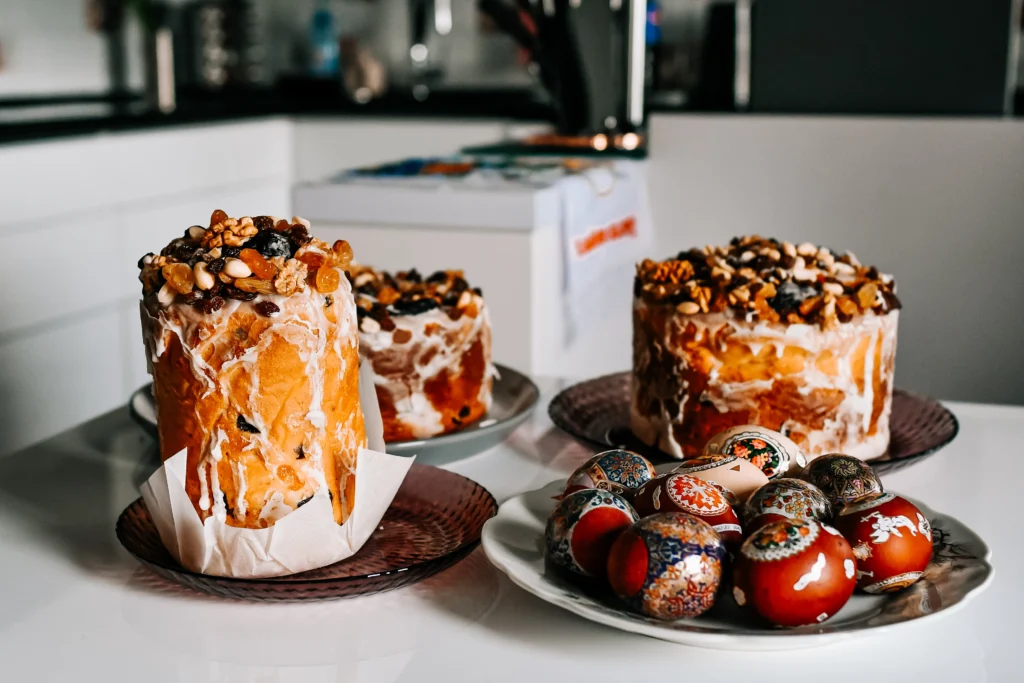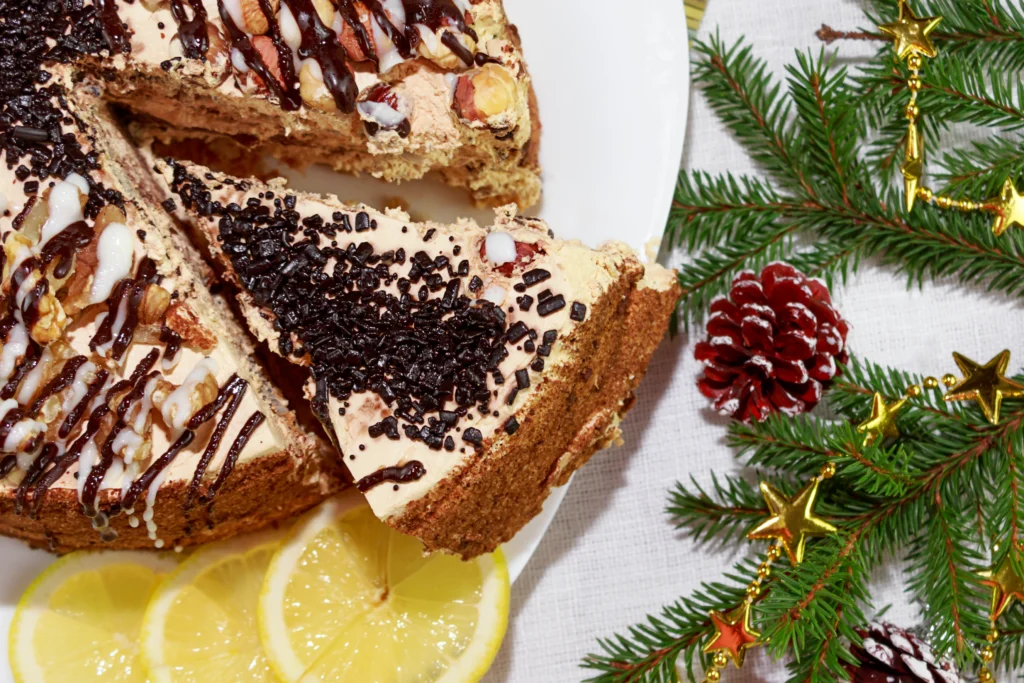Delicious Italian Fruit Cake: What Is Panettone? Explore the Beloved Tradition
As Christmas nears, the smell of panettone fills the air. This sweet bread from Milan has won hearts worldwide. It’s known for its light texture and rich flavor, making it a holiday favorite.
The name “panettone” comes from “panetto,” meaning small bread, with “-one” adding grandeur. This Italian fruit cake is a mix of dried fruits, candied peels, and sometimes chocolate. Unlike regular fruitcakes, panettone isn’t too sweet. It’s great as a dessert, for brunch, or with coffee or tea.
Table of Contents
The Rich History and Origins of Panettone
Panettone, a beloved italian holiday treat and festive italian sweet, comes from Milan, Italy. The first mention of this xmas italian cake was in 1599. It was in an expense register at the Borromeo College of Pavia.
In the 18th century, Pietro Verri linked panettone to Christmas. This connection has stayed strong ever since.
From Milan to Global Holiday Favorite
In the early 1900s, Angelo Motta and Gioacchino Alemagna changed panettone. They made it the tall, domed shape we see today. After World War II, panettone became a top Christmas treat in Italy.
It then spread worldwide as Italian immigrants shared it with others.
Evolution Through Italian History
Panettone’s history goes back to the 13th century. Back then, wealthy Milanese enjoyed a special bread. This bread was filled with many ingredients.
By the 1500s, recipes for this treat were written down and improved. It became the fluffy, sweet treat we love today.
Industrial Revolution of Panettone Production
The big change in panettone’s history was in the early 1900s. Angelo Motta and Gioacchino Alemagna made it easier to make. They mass-produced the italian holiday treats.
This made panettone more popular. It became a favorite festive italian sweet and xmas italian cake.
| Year | Milestone |
|---|---|
| 1599 | First recorded mention of panettone in an expense register at the Borromeo College of Pavia |
| 18th century | Panettone’s association with Christmas season documented by Pietro Verri |
| Early 20th century | Bakers Angelo Motta and Gioacchino Alemagna industrialize panettone production, giving it its iconic domed shape |
| Post-World War II | Panettone becomes Italy’s leading Christmas sweet and spreads globally through Italian immigrants |
“Panettone embodies the spirit of the season like joy, sharing, and togetherness.”
Understanding the Classic Italian Fruit Cake
Panettone, the iconic Italian Christmas cake, is a yeast-leavened delight. It has captured the hearts and palates of baking enthusiasts worldwide. This beloved baked good has a rich history, dating back to the 13th century.
It has evolved into a cherished tradition. Its distinctive cylindrical base and dome-like top are typical. A 1 kg cake usually stands 12-15 cm high.
The rich history of panettone is deeply rooted in its carefully crafted recipe. It includes strong bread flour, dried fruits, candied peel, and nuts. These ingredients create a complex and flavorful cake.
An essential element of the panettone-making process is the soaking of dried fruits in liqueur or fruit juice. This step infuses the cake with a delightful sweetness and depth of flavor.
While the traditional panettone recipe has remained largely unchanged, modern interpretations have introduced exciting variations. These include chocolate chip versions and even star-shaped cakes like pandoro. These innovative takes on the classic Italian fruit cake showcase the versatility and enduring appeal of this beloved holiday treat.
Crafting the Perfect Italian Fruit Cake
The art of making the perfect Italian fruit cake, such as panettone, is a delicate balance of precision and patience. The batter for these decadent cakes typically consists of high-quality ingredients like butter, sugar, eggs, milk, and fast-acting dry yeast. These ingredients are carefully combined to achieve the desired texture and flavor.
Proper proofing techniques, including overnight chilling, are crucial. They ensure a light and airy crumb structure in the finished product. Experienced bakers emphasize the importance of using top-notch ingredients and allowing sufficient rising time to attain the ideal texture in their fruitcake recipe.
| Ingredient | Purpose |
|---|---|
| Strong bread flour | Provides structure and rise |
| Dried fruits and candied peel | Adds sweetness and texture |
| Nuts | Enhances flavor and crunch |
| Liqueur or fruit juice | Infuses the cake with depth of flavor |
| Butter, sugar, eggs, milk | Creates a rich, decadent batter |
| Fast-acting dry yeast | Facilitates the rising process |
While the process of making pandoro, another classic Italian baked goods from italy, may involve slightly different techniques, the underlying principles of achieving the perfect texture and flavor profile remain the same. Both panettone and pandoro have become beloved symbols of the Italian Christmas season, delighting taste buds around the world.
Essential Ingredients and Traditional Components
The Italian panettone is a beloved fruit cake known worldwide. It’s made with a special mix of ingredients. These ingredients create its light and airy texture.
Core Ingredients for Authentic Panettone
Traditional panettone starts with strong bread flour, yeast, eggs, sugar, milk, and butter. These ingredients make the cake soft and fluffy. Dried fruits and candied citrus peels add flavor and texture.
The Role of Natural Yeast and Fermentation
Natural yeast and a long fermentation are key to authentic panettone. The yeast and proofing time develop the cake’s flavors and structure. The dough proofs at 75°F to 80°F for one to three hours.
Traditional Fruits and Flavorings
Traditional panettone also includes dried fruits and flavorings. Raisins, candied orange and lemon peel, and glace cherries are common. They add to the cake’s taste and look.
| Ingredient | Quantity | Purpose |
|---|---|---|
| Bread Flour | 500g | Provides structure and texture |
| Sugar | 200g | Sweetens the dough and enhances flavor |
| Eggs | 5 large | Enriches the dough and contributes to the cake’s tender crumb |
| Butter | 200g | Adds richness and moisture to the cake |
| Milk | 100ml | Provides additional moisture and contributes to the cake’s softness |
| Dried Fruits | 300g | Adds pops of flavor and texture throughout the cake |
| Candied Citrus Peels | 100g | Enhances the fruity notes and aroma of the cake |
The Art of Making Panettone
Making the perfect panettone is a true labor of love. This iconic Italian christmas baking and italian fruit cake recipe needs patience, precision, and dedication. Every step, from the dough to the cooling, is key to its light, airy, and sweet texture.
The dough starts with a mix of yeast, flour, sugar, eggs, and butter. It rises for hours, thanks to fermentation. Then, dried fruits and candied peels are added, bringing flavor and texture.
Shaping the panettone is an art. The dough is placed in molds or paper cases to get its dome shape. This rise is crucial for its light crumb.
Baking the panettone is precise. It takes about an hour to get the perfect golden color. After baking, it’s cooled upside down to keep its shape and texture.
The result is a remarkable confection. It shows the skill and dedication of Italian pastry chefs. Panettone is a celebration of Italy’s culinary heritage, enjoyed as a festive centerpiece or snack.
| Step | Description |
|---|---|
| Dough Preparation | Mixing yeast, flour, sugar, eggs, and butter to create the foundation of the panettone dough. |
| First Rise | Allowing the dough to rise for several hours, enabling the natural fermentation process to work its magic. |
| Second Kneading | Incorporating dried fruits and candied peels into the dough, adding layers of flavor and texture. |
| Shaping and Final Rise | Carefully placing the dough into specialized molds or paper cases to achieve the iconic dome shape, and allowing for a final rise. |
| Baking | Carefully monitoring the baking process, ensuring the panettone achieves the perfect golden-brown hue. |
| Cooling | Hanging the panettone upside down for 24 hours to maintain its shape and airy texture. |
“Making panettone demands precision and patience, with the right pH and alcohol levels crucial for achieving the desired texture and taste.”
Unique Characteristics and Texture Profile
When you think of a panettone, its domed shape and light texture are what stand out. This classic Italian cake is known for its special features. These make it different from other holiday treats.
The Distinctive Dome Shape
The panettone’s shape comes from a special baking process. As the dough rises, it forms a tall dome. This dome shape is not just for looks. It also helps make the panettone light and fluffy.
Signature Light and Airy Crumb Structure
The panettone’s texture comes from long fermentation and quality ingredients. The dough proofs for days, creating a soft, pillowy crumb. This makes the cake rich yet delicate, with a chewy yet soft quality.
The panettone’s buttery taste is balanced by the sweetness of dried fruits and candied peels. This mix of flavors and textures makes the panettone a favorite holiday treat.
Modern Variations and Flavor Innovations
Traditional italian christmas cakes like panettone often have dried fruits and candied peels. But today, bakers are trying new things. They use unique ingredients and mix flavors in creative ways. This makes gourmet panettone for everyone.
Some bakers add chocolate chips, nuts, or different fruits to their panettone. Others skip the dried fruits and go for vanilla or chocolate. These festive italian sweets show how panettone can be enjoyed in many ways.
Even with all the new ideas, many bakers stick to old recipes. They want to keep the true taste of panettone alive. This mix of old and new keeps panettone special and true to its roots.
| Traditional Panettone | Modern Panettone Variations |
|---|---|
| Made with dried fruits and candied peels | Chocolate chips, nuts, alternative fruit blends |
| Adheres to classic recipes and methods | Focuses on unique flavors like vanilla or chocolate |
| Maintains authentic Italian character | Showcases versatility and innovation |
Whether it’s old ways or new flavors, panettone is a symbol of Italian cooking. It shows the tradition and creativity of Italian cuisine.

Serving and Storage Traditions
Panettone is a famous Italian holiday treat loved by many. It’s a Christmas cake enjoyed around the world. Serving it right is key to enjoying it fully.
Proper Cutting and Serving Techniques
Panettone is cut vertically, not horizontally. This keeps its domed shape and light texture. It’s cut into wedges, so everyone can enjoy its layers and flavors.
It’s great with sweet drinks like coffee, tea, or hot chocolate. You can also pair it with dessert wines like Asti or Moscato d’Asti. In some places, it’s enjoyed with mascarpone spread.
Storage Methods for Maximum Freshness
- Keep your panettone fresh by storing it in an airtight container at room temperature for up to a week.
- If you need to store it longer, freeze it for up to two months. Let it thaw slowly in the fridge before serving.
- Don’t store panettone in the fridge or freezer. It can lose its texture and flavor.
By following these tips, your panettone will stay delicious. It will be a wonderful part of your Italian holiday treats.
Cultural Significance and Holiday Traditions
Panettone, the iconic Italian Christmas cake, holds a deep cultural significance in Italy and Italian communities worldwide. It becomes a staple at gatherings during the holiday season. Often, it’s given as a thoughtful gift to family and friends.
The cake’s popularity has spread globally, making it a cherished Italian christmas traditions and a beloved xmas italian cake in many countries.
In South America, particularly Peru, the consumption of panettone has surpassed even Italy. Peruvians consume an average of 1.3 kg per person annually. This widespread adoption shows the cake’s universal appeal and its ability to transcend cultural boundaries.
Panettone’s rise to global fame has made it a sought-after treat in many countries. Creative variations have emerged to cater to diverse palates. From the classic fruit-studded version to innovative flavors like chocolate, pistachio, and beyond, the versatility of panettone ensures it remains a cherished centerpiece of italian christmas traditions and xmas italian cake celebrations worldwide.
“Panettone is not just a cake, it’s a symbol of Italian culture and tradition. It brings people together, creates memories, and celebrates the spirit of the holiday season.”

The cultural significance of panettone extends beyond its delicious taste and festive appearance. It represents the rich tapestry of Italian culinary heritage. Generations-old recipes and time-honored techniques converge to create a truly unique and beloved holiday treat.
As the world embraces the italian christmas traditions and xmas italian cake, panettone continues to bridge cultures. It brings a taste of Italy to Christmas celebrations everywhere.
Conclusion
Panettone has grown from a local treat in Milan to a worldwide symbol of Italian Christmas. Its special texture, rich history, and flexibility have made it very popular. It’s a beloved part of holiday celebrations, linking people to Italy’s food and festive traditions everywhere.
The story of panettone goes back to the 15th century in Milan, Italy. Fruitcake, on the other hand, has roots in ancient Rome. Both holiday treats, though different, share a common spirit of the season. Panettone is light and fluffy, with dried fruits and spices, unlike the dense, moist fruitcake filled with nuts and alcohol.
Now, panettone is loved in many places around the world, like South America, Canada, Eastern Europe, and North Africa. It can be enjoyed alone, with butter or Nutella, or in creative dishes. Its lasting appeal shows how Italian food can unite people and celebrate the holiday season.

